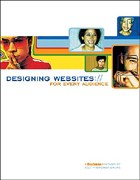...continued from previous page...
Organizing content based on "who" rather than "what"
- Benun:
- My original idea was to organize the book by design element: color, page layout, typography, etc. But as I tried to work with that, it just didn't make sense. I saw a need to re-focus the flow of the book to target reader positioning just as the designer should.
I did a lot of research and these reader profiles began to emerge as the primary categories of positioning. So I ran that by my publisher, they liked it and we restructured the whole book mid-stream. Lots of work but in the end a much better product.
- DT&G:
- Ah, I see. It's a brilliant concept -- I've seen web design books structured according to site personality, (such as Robin William's "Web Design Studio") but it truly makes a lot of sense to focus on types of readers rather than types of sites.
So now, the book becomes a manual of sorts? Right?
- Benun:
- That's right. People don't need to read the whole book in order to get the information they need for the particular kind of site they're working on. People these days don't have time to do much more than skim through a book and read the one or two chapters that apply most to them.
- DT&G:
- So true!
I really enjoyed studying the sites you illustrated as examples in each chapter. Were these recommended to you, or did you have to do a lot of surfing to find sites that matched the user profile?
- Benun:
- This was, by far the most difficult part of the process. I had to whittle down 100 or more sites to get the final 25.
The hardest part was finding sites that were both usable and aesthetically-pleasing. Most were either one or the other. I reached out to designers, usability experts and web site developers but found very few whose knowledge and perspective intersected or overlapped the two areas, which clearly illustrates the issue I'm trying to address. I knew they were out there, however, so I kept surfing: lists of Web sites that others had found usable, lists of web sites that had won awards for design, aimless surfing even, and finally, recommendations from people, one at a time, who said, "check this site out." In fact, that's how I found most of the ones I ended up using.
- DT&G:
- After that, what came next?
- Benun:
- Once I found sites I wanted to use, I had to find the person on the team who could answer my questions, at which point I still wasn't even sure I was asking the right questions. I put out a request on a usability email list to find help and assembled a team of 14 technical advisors who were willing to help me, and did as I reconfigured the book and recommended sites. The most successful strategy was following every lead that came my way.
- DT&G:
- Okay, let's dig into some of that content. The primary directive is "Knowing Your Users" as a key to designing successful visual communication projects. What might be the most important criteria for assessing those users?
Ilise answers as we continue on the next page...

- Ilise Benun
- Ilise Benun is the author of "Designing Web Sites for Every Audience" (HOW DESIGN Books, 2003) and "Self-Promotion Online" (HOW Design Books, 2001). She has written many articles about online marketing and published The Art of Self Promotion, a quarterly newsletter of nuts 'n bolts for manageable marketing, for 10 years.
You can download an excerpt of the book at:
http://www.junecreative.com/news/dwfea.html. Don't forget to check out Ilise's "art self-promotion" and Quick Online Marketing Tips newsletter.
- Copyright: 4/5/2003, all rights reserved
Return to the Critique
Department Index | Or: Select
a reader site to review!
Design &
Publishing / WebDesign
& Review / See
the current newsletter
Submit your web site for review... by using the Website
Input Form.
Become a WebDesign reviewer! ...become a regular, and be promoted by The Design
Center. Just review some sites that have been sent in by readers. Post your reviews
individually to our REVIEWS
page, where you'll find everything you need. If you'd like to publish your articles,
hints, tips or tricks in the pages of WebDesign & Review then read our "Readers Guidelines."
Thank you for visiting WebDesign & Review at http://www.graphic-design.com/web/
Notes: The screen shots herein represent the copyrighted works of their respective owners, and are used here for editorial demonstration purposes. Permission has been granted to display and review all sites in WebDesign & Review by the website owners. Please read and be aware of our Legal Properties & Disclaimers document.
ALL RIGHTS RESERVED. Copyright 1996, 1997, 1998, 1999, 2000, 2001, 2002, 2003 Showker Graphic Arts, for the The Design & Publishing Center. WebDesign & Review, Pixelsmith, WebEye are all trademarks for The Design & Publishing Center. WebDesign & Review is a wholly owned publication of Showker Graphic Arts & Design, Harrisonburg, Virginia, USA. Other products mentioned in these pages are the registered trademarks of their respective owners.
|

